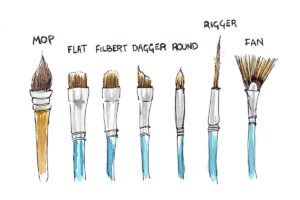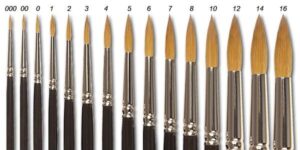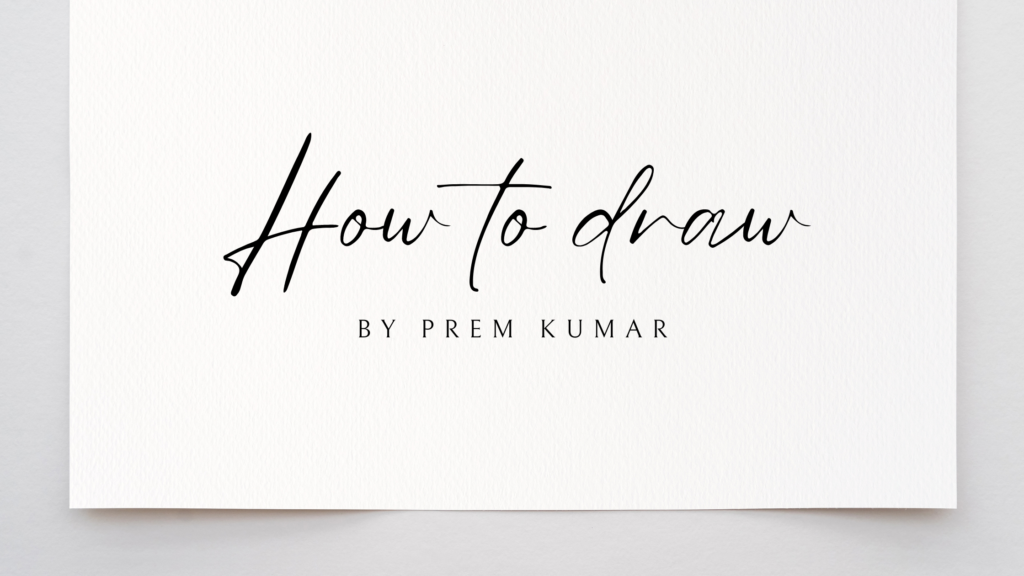Watercolor brushes are essential tools in watercolor painting’s delicate and expressive art style.” Their various shapes, sizes, and applications have a significant impact on the outcome of your task. We will dig into the realm of watercolor brushes in this detailed introduction, covering their various features and applications.

Understanding Watercolor Brush Shapes:
Watercolor brushes come in a range of shapes, each with its purpose. Understanding these shapes is critical for creating various textures, strokes, and effects in your paintings.
1. Round brushes:
The most versatile and widely used watercolor brushes are round brushes. They are available in a range of sizes, from 000 to 24, and feature a sharp tip that enables for accurate detailing and delicate lines. These brushes are excellent for outlining, sketching, and adding fine details to your artwork.
2. Flat Brushes:
Flat brushes, with their squared-off tips, are ideal for covering vast areas and creating broad strokes. They come in a variety of sizes, with the larger ones being ideal for washes and backgrounds. A flat brush’s straight edge can also be used to create crisp lines and defined shapes.
3. Filbert Brushes:
Filbert brushes have an oval-shaped, rounded tip, which combines the advantages of round and flat brushes. These brushes are quite versatile and may be used for a variety of methods, including generating rounded edges and broad strokes. Filbert brushes are fantastic for blending and softening edges in watercolor paintings.
4. Angular Brushes:
The flat, angled tip of an angular brush allows for accurate lines and strokes. These brushes are ideal for painting tough corners and edges. They are a flexible addition to your brush collection because they can be used for both intricate work and large sweeps.
5. Rigger Brushes:
Rigger brushes, also known as liner brushes, have long, thin bristles that come to a sharp tip. These brushes are ideal for painting detailed details such as tree branches, hair strands, or tiny textures since they are meant to create long, continuous lines.

Understanding Watercolor Brush Sizes:
Selecting the appropriate brush size is critical for attaining the desired results in your watercolor paintings. A number represents the size of a brush, with smaller values denoting smaller brushes.
1. Small brushes (sizes 000 to 2):
Small brushes are ideal for small lines, elaborate designs, and detailed work. They are necessary for incorporating delicate characteristics into your works, such as face features, little objects, or subtle textures.
2. Medium brushes (sizes 4 to 8):
Medium-sized brushes provide a good blend of minute details and wide strokes. They are adaptable and can be used for a wide range of tasks, from outlining to filling in medium-sized regions.
3. Large brushes (sizes 10 and up):
Large brushes are ideal for swiftly covering large areas. They are frequently used for washes, backdrops, and strong strokes. These brushes are essential for creating vibrant, expressive watercolor paintings.
Understanding Watercolor Brushes:
Now that we’ve looked at the various shapes and sizes of watercolor brushes, let’s talk about how they might be used in the artistic process.
1. Backgrounds and washes:
Large, flat brushes are ideal for creating smooth backgrounds and applying equal washes. These brushes’ broad strokes can provide a firm foundation for your painting.
2. Outlining and Detailing:
Round brushes are great for adding delicate details and highlighting the major features of your artwork, especially in smaller sizes. Their sharp tips enable precise capture of small lines and delicate characteristics.
3. Softening and blending:
In watercolor paintings, filbert brushes are excellent for blending and softening edges. Their rounded tips enable for smooth color transitions, resulting in a more natural and harmonious appearance.
4. Special Effects and Textures:
Rigger brushes are essential for producing textures and unique effects. Rigger brushes excel in providing the necessary precision when painting a textured surface, such as tree bark, or adding detailed lines to suggest movement.
Conclusion:
Brushes are more than simply tools in the field of watercolor painting; they are instruments that allow artists to bring their thoughts to life. Artists can elevate their work by learning the forms, sizes, and uses of watercolor brushes, adding depth, detail, and expression to their creations. Experimenting with different brushes can help you discover your own style and approach, allowing you to fully realize the possibilities of watercolor as a medium for artistic expression. So, the next time you take up a watercolor brush, think of the possibilities that each shape and size offers, and let your imagination flow into the canvas.
Also Read: Understanding Brush Bristles: Natural vs. Synthetic Fibers
Also Read: A Comprehensive Guide to Brush Selection
Watercolor Brushes recommendation:
1. Artist’s Den Hobby Essentials Brushes Click Here
2. ARTIOS Round Paint Brushes Click Here
3. RIANZ Painting Brushes Click Here
To learn more about art, visit SILPAVAT.IN


